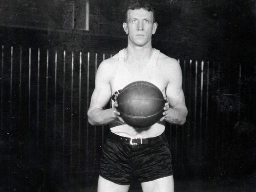(This article was written in January 2003, just after the Canadian Junior Hockey Team had lost the gold medal in the World Championships of that year. They lost to the Russians, which is no shame, but...)
Silver is silver, and we can still bask nationally in the sun of Salt Lake, but there was something in that oh-so-close loss to the Russian juniors that was irritating. Our man Fleury was superb in goal and probably won his M.V.P. award on the strength of that last game, and the Canadian boys were plucky but overmatched. It really wasn’t that close. The thing that got to me, though, was the tearful commentary of one of the lads, trying to figure out what had happened to him, his mates, his nation. “We gave everything we had, we played with lots of heart…” Ugh. Heart. When will we realize that’s not enough?
Of course they played with heart. That’s a given, isn’t it? Yes, and our Canadian men fought with brilliant heart at Dieppe, too, but we remember equally the criminal lack of preparation with which they launched themselves against a mighty foe. Please don’t mistake me, I don’t equate the two enterprises; I just wonder, with the 30th anniversary of the Summit Series having just passed, when Canadian hockey men will finally admit that we can learn about Our Game from people who don’t come from Kingston, Ontario? Captain Scottie Upshall did (“that’s a great team over there, they must be doing some things right in Russia”), and it’s astonishing, from where I sit, that we still teach our young players that heart is pre-eminent.
The situation in other sports is instructive. Holger Osieck, a German, was brought in to coach our national men’s soccer side. He deplored the Canadian style of play, which involved a lot of long hopeful kicks and furious running—can you say “dump and chase”?—and immediately required ball-control strategies. Not only that, he had asked for and been granted the authority to dictate his methods to the feeder elements of the national program; there is a unity of purpose here that is strikingly absent in Canadian hockey.
Last summer’s World Championships of basketball provide an example that Canadian hockey-lovers should recognize. The Americans entered their “Dream Team” in Barcelona in 1992, their college all-star teams having lost in ’72 (“we wuz robbed!”) and ’88 (“oh-oh, they’re catchin’ up!”). The youngsters were vulnerable, but when they sent Michael, Larry, and Magic, it was no contest. Until, ten years later, it was. The national hand-wringing after NBA players fell so clumsily last summer was eerily familiar to Canadians. ESPN commentator Jay Bilas, a former Duke University star, was most eloquent. Even when the Americans still had their chance to win (after losing to Argentina in pool play), Bilas was sounding the alarm. We can’t just throw all-star teams together. We need to prepare. Our kids aren’t learning skills. They play too much and practise too little. The Europeans have better fundamentals…Sound familiar? Their first wake-up call came in 1972, when the Soviets won Olympic gold in Munich, but their true dominance of basketball remained unquestioned. Last summer, for American hoops, was a closer analogy to the periodic bouts of Canadian dismay that began in ’72. Our experience in self-examination allows this prediction. American basketball chauvinists will prevail. They’ll learn some small technical lessons from Indianapolis, but dismiss it as an aberration. Shrill voices will occasionally demand a fundamental rethinking of the way “our game” is approached. They will be ignored. And the rest of the world will continue to improve…
The Americans could learn a lot from our experience as the erstwhile “first nation” of hockey (or England’s in soccer, for that matter, which finally, desperately, hired Sven Goran Eriksson as its first foreign national coach; imagine that happening in USA Basketball, or Hockey Canada!). But they won’t. We haven’t learned. Our pride in the Canadian Way to Play is quaint, but it is increasingly relegating our top athletes to “role player” status, while the NHL imports its dazzle. What’s worse is that we’ve accepted this so completely, even romanticizing it as the demonstration of genuine passion, true “heart”, and the virtues of “old-time hockey”. Amazingly, even the careers of Wayne Gretzky and Mario Lemieux have not removed a rather defensive attitude of suspicion toward players, Canadian or otherwise, who are distinguished by their skill and cleverness. Gretzky seems poised to act as the national face of hockey, and his insistence on a game of puck movement and speed for our Olympic teams bears great promise. Are Canadian youngsters, and especially coaches, more likely to hear that quadrennial voice, or Coach’s Corner on Saturday evenings?
Hint—yesterday’s National Post had this headline on its front page: “Oh, stop crying already! Canada still rules hockey”. Accompanying stats in which Canada had a record superior to the Russians (leading NHL scorers, Olympic wins, world junior wins) was an article peppered with the observations of, you guessed it, Don Cherry. We were missing players that their NHL clubs wouldn’t release, and so on. For all the truth contained in the article, it’s a reminder of how defensive Canadian hockey types can get, a sort of emotional left-wing lock. This shouldn’t be a dark period of national self-examination; Lord knows we have more serious matters to debate. But let’s hope that we teach our kids to better know and love the wizardry and speed of the game. The heart will follow.

